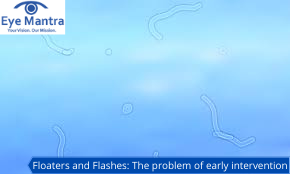Contents
Floaters And Flashes
Sometimes you experience this strange phenomenon called floaters of flashes in your eyes. Floaters are small indistinctive little shapes and forms that you see when while blankly staring at the sky of a wall sometimes. These floating little things can look like a dirty camera lens. Floaters are nothing but solidified of shrinking gel like substance present in your eyes called the vitreous, present in the middle of the eye with other structures that help you see the outside world. While flashes are sudden surges of light in your eye, they might feel like a camera flash or lightening.
Floaters and the shrinkage of vitreous humour is quite normal and occurs as a symptom of aging. So, it should not be made a cause of concern. However, if you observe a sudden surge or increase in these then you must consult your ophthalmologist immediately as it can be an indication of some eye ailments that need immediate attention.
What Are Floaters And Flashes In The Eyes?

A floater can be used as a collective term for the specks, threads, and cobweb-like images that drift across the line of vision of the person. It is referred to specks or clouds moving in one’s field of vision that can be seen more clearly while looking at a plain background, such as a blank wall or the plain blue sky. Floaters are nothing but tiny clumps of gel or cells present inside the vitreous of the eye. They come in different shapes, such as little dots, circles, lines, clouds, or even cobwebs.
Though these ameboid objects you see look like they are in front of your eye but, they are floating inside of it. What the person sees is not the actual object, but its shadow is being casted on the retina. Floaters may be dangerous, especially if they develop suddenly.
Why Do We Experience Floaters And Flashes?
Floaters or specs of blobs and shapes that appear in the eye are not a big deal and is quite normal. It usually happens when the vitreous humour starts to contract due to aging. 40-50% of the older population has a detached vitreous humour. However, if you experience sudden surge in the intensity or density of these floaters or flashes of light, loss of peripheral vision, blurred vison or pain in the eyes, then it might be time to get professional help.
The term “flashes” in the eyes is used for the sparks or strands of light that move across and disturb the visual field of the person. When the vitreous gel present inside the eye, rubs away or pulls off the retina, the person may see something that looks like flashing lights or something close to lightening streaks. This sensation might have been experienced by people who, at some time in their life ever have been hit in the eye and seen “stars”.
These flashes of light and lightening streaks in the eye can continue to appear off and on for several weeks or months. The phenomenon of flashes occurring to a person is also a part of the aging process and hence becomes more common as one grows older. If you notice the sudden appearance of flashes, you should visit your ophthalmologist immediately.
Ageing And Floaters And Flashes?
Both floaters and flashes are usually the part of one’s aging process and hence become more prominent as one grows up. As one grows older, his vitreous (a thick gel attached to the retina of the eye) becomes thinner and watery each day. As a result, the vitreous becomes so weak that it ultimately pulls off from the retina. It becomes loose and hence starts moving around, casting its shadow on the retina.
This condition is medically termed as Posterior Vitreous Separation or Detachment (PVD). What exactly happens during PVD is that the remaining tissue that was originally safely secured inside the vitreous loosens and starts moving around in the eye. This casts a shadow on the retina and hence the person concerned begins to experience a lot of visual disturbances just like flashes and floaters.
If the vitreous is more sticky than normal or the person has a weak retina, a condition called retinal tear can occur. Retinal tears to many patients, occur as flashes of light. These tears are risky as they can cause bleeding into your vitreous gel. The blood appears the same as a typical floater in the person’s field of vision.
The scary thing is that the retinal detachment that can occur if the liquid vitreous enters the break. Retinal detachment is a serious and a more severe condition than floaters and flashes. It can lead to potential blindness.
Are Frequent Floaters and Flashes okay?
When people reach middle age, the vitreous gel may slowly and gradually start to shrink, forming tiny clumps inside the eye. Floaters often occur when the vitreous gel pulls away from the retina, causing a posterior vitreous detachment (PVD). In some cases, the retina can even tear apart as the shrinking vitreous gel pulls away from the wall of the eye. A torn retina is always a serious issue since it can lead to a retinal detachment.
While floaters and flashes in the eye are caused by the shrinking of the gel-like fluid called vitreous in the eye. Floaters appear as small-sized shapes in your field of vision. Flashes look like lightening streaks or camera flashes, both floaters and flashers are usually harmless but can be a warning sign of some incoming serious trouble in the eyes. Worse cases occur when these disorders suddenly appear or become more plentiful. The main cause of floaters and flashes is the vitreous becoming thinner with age, more of which is discussed in a later section. You should see an ophthalmologist right away if you suddenly develop new floaters.
Common Causes of Floaters and Flashes
Eye Injury
If you have recently sustained an eye injury or was hit in the eye it is more likely that you will experience floaters and flashes.
Near-sightedness
People who suffer from Vitreous Syneresis and near-sightedness are more likely to experience floaters and flashes as well. Near-sightedness is also called myopia.
Cataract Surgery
Cataract surgery can lead to Posterior Vitreous Detachment in which the tissues inside the vitreous get detached and hence cast shadow on the retina. This condition can lead to the person experiencing what we call them as floaters and flashes.
Diabetes
Floaters and flashes are counted among the prominent symptoms of diabetic eye disease. If a person is diagnosed with diabetes, there are probable chances of him developing the diabetic eye or retinopathy which in turn makes floaters and flashes. Diabetes can damage the vascular system of the eye leading to gross inflammation and hence floaters and flashes can be one of the early symptoms. If not given the required attention and care, then the diabetic patient can also experience loss of vision or blurred vision.
Retinitis
Retinitis is caused by ocular inflammation occurring due to infections caused by viruses, bacteria or even parasites. While most of the people suffering from retinitis do not experience any symptoms at the time of the diagnosis some of them experience floaters. These floaters can be debris or damaged cells getting in the way of the path of light of even blood. Floaters and decreased vision are declared to be the only symptoms of retinitis observed so far.
Children birthed out of mothers who were exposed to pathogens may have misaligned eyes, involuntary eye movement or white reflex in the pupil.
Infection in The Eye
Any sort of infection in the eye causes inflammation in the layers of the uvea at the back of the eye. This in turn release inflammatory debris into the vitreous that is seen as floaters by the eye.
Treatment For Floaters and Flashes

Floaters and flashes are a problem for many people. Although, the flashes and floaters do not pose any immediate threat to the human eye. They can prove troublesome in some serious cases. Except for severe cases, these disorders do not require medical treatment other than regular monitoring of the eye. However, if the person experiences symptoms, he should visit an ophthalmologist to avoid further complications.
The eye patients that are being affected by disturbances in their vision or those who have experienced significant visual interferences should seek out of proper medical assistance.
Floaters and flashes are temporary problems and are generally expected to get recovered within a few months. However, in some special cases, the disorders demand medical treatment for the improvement of the condition of vision. Hence, for the treatment of floaters and flashes, many specialists prescribe eye drops as an initial medical help. When the eye drops cannot do the trick anymore, treatment becomes necessary to reduce the appearance and the problems being caused due to flashes and floaters. In such cases, surgery becomes the ultimate option of treatment to replace the vitreous gel. This procedure, known as a pars plana vitrectomy removes the natural vitreous of the patient’s eye and replaces it with another fluid.
In the case of retinal detachment, as described before emergency medical treatment is necessary to prevent serious complications in the future. With treatment, most patients, even those with retinal tears, can restore their healthy vision. The best way to treat your eyes is to visit your eye care professional and get your eyes checked regularly. They will be able to assess the best method of treatment for your eye ailment. Visit our website Eyemantra.To book an appointment call at +91-8851044355. Or mail us at [email protected] other services include Retina Surgery, Specs Removal, Cataract Surgery, and many more.



